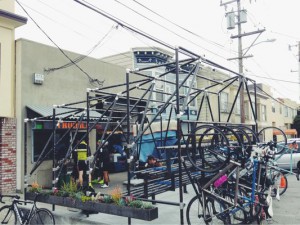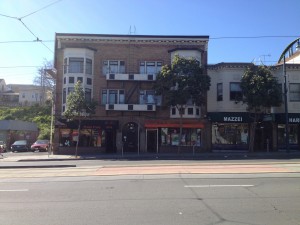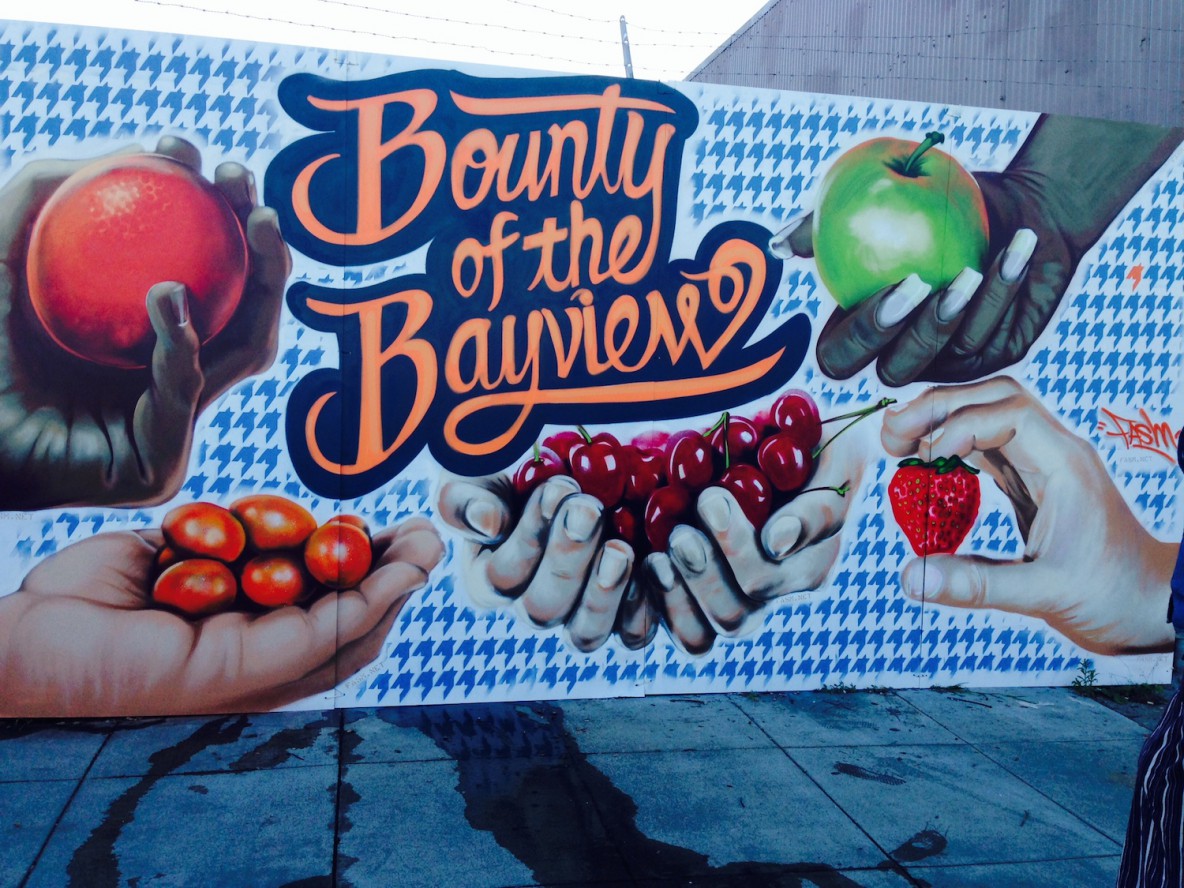Tomás León is an MS/PhD student in environmental Health Sciences at the School of Public Health at UC Berkeley. He and his Spring 2014 Eat.Think.Design. teammates Nora Gilbert and Alissa Bernstein created a Food Innovation District Action Plan for a client at the San Francisco Planning Department as part of their Eat.Think.Design. final project. Here, Tomás writes about a day walking around in the Bayview neighborhood, reflecting on some of his team’s project insights. Read the full Action Plan developed by Team Eat Drink Bayview for more information about their project.
The Bayview, like most neighborhoods, is a complicated place to work. This was exemplified on the day of our Innovation Feast presentations, when I went to Bayview to pick up desserts from Yvonne’s Southern Sweets for tasting after our project talk. I first stopped by Trouble Coffee on Yosemite Ave., where I would often visit to shoot the breeze with the barista (usually Dan, a fellow ex-pat from Georgia)  and the clientele, who, while diverse, often tip toward the hipster end of the spectrum. The only parklet in the Bayview is outside of Trouble Coffee, which is also famous for the toast phenomenon recently featured on This American Life. I view Trouble as a symbol of the influence from the rest of San Francisco into Bayview that has been more palpable of late as housing prices have gone through the roof and people are seeking out more affordable accommodations. Trouble is not a longtime stalwart of the neighborhood, but it has managed to generate quite a following already. I usually stop in during the day and am joined by construction workers and others who are in the area for their jobs.
and the clientele, who, while diverse, often tip toward the hipster end of the spectrum. The only parklet in the Bayview is outside of Trouble Coffee, which is also famous for the toast phenomenon recently featured on This American Life. I view Trouble as a symbol of the influence from the rest of San Francisco into Bayview that has been more palpable of late as housing prices have gone through the roof and people are seeking out more affordable accommodations. Trouble is not a longtime stalwart of the neighborhood, but it has managed to generate quite a following already. I usually stop in during the day and am joined by construction workers and others who are in the area for their jobs.
 After getting my cappuccino fix, I walked over to Frisco Fried for lunch, a popular soul food restaurant on Third Street that had been recommended to me but that I had not eaten at yet. Today was the day. I ordered the house special: chicken & waffles (Note: if you have never eaten chicken & waffles, stop reading this blog post immediately and proceed to your nearest chicken & waffles establishment to remedy this travesty). It was delicious, fried to order and with hot sauce provided. I noticed immediately how different the customer base was from over at Trouble. Predominantly African-American except for an Asian-American businessman who must also appreciate the culinary wonder of chicken & waffles. Blaring on the TV was a discussion of why black men had trouble succeeding in the white world of NBA corporate (probably related to the recent dismissal of Donald Sterling from the Clippers). An interesting point to think about, as the historically-African American Bayview-Hunters Point neighborhood, home of the Black Cuisine Festival, often faces challenges from the Bay Area food establishment that looks down on black cuisine as inherently unhealthy and undesirable.
After getting my cappuccino fix, I walked over to Frisco Fried for lunch, a popular soul food restaurant on Third Street that had been recommended to me but that I had not eaten at yet. Today was the day. I ordered the house special: chicken & waffles (Note: if you have never eaten chicken & waffles, stop reading this blog post immediately and proceed to your nearest chicken & waffles establishment to remedy this travesty). It was delicious, fried to order and with hot sauce provided. I noticed immediately how different the customer base was from over at Trouble. Predominantly African-American except for an Asian-American businessman who must also appreciate the culinary wonder of chicken & waffles. Blaring on the TV was a discussion of why black men had trouble succeeding in the white world of NBA corporate (probably related to the recent dismissal of Donald Sterling from the Clippers). An interesting point to think about, as the historically-African American Bayview-Hunters Point neighborhood, home of the Black Cuisine Festival, often faces challenges from the Bay Area food establishment that looks down on black cuisine as inherently unhealthy and undesirable.
 On the way to Yvonne’s, I was sold a newspaper, a copy of the The Final Call, by a local student as part of a “school fundraiser.” The Final Call is affiliated with the Nation of Islam, a group whose stated goal is “to improve the spiritual, mental, social, and economic condition of African Americans in the United States and all of humanity.” Clearly, some of the influences discussed by James Baldwin in the 1960s documentary Take This Hammer are still at work in Bayview-Hunters Point.
On the way to Yvonne’s, I was sold a newspaper, a copy of the The Final Call, by a local student as part of a “school fundraiser.” The Final Call is affiliated with the Nation of Islam, a group whose stated goal is “to improve the spiritual, mental, social, and economic condition of African Americans in the United States and all of humanity.” Clearly, some of the influences discussed by James Baldwin in the 1960s documentary Take This Hammer are still at work in Bayview-Hunters Point.
Next, I stopped by an ATM to pay for my purchase at Yvonne’s. A security guard (who identified himself as living near Nob Hill but working in the Bayview) approached me and inquired, “Wouldn’t you rather be anywhere but here right now?”
“Why is that?” I asked. “Seems alright to me. Weather’s good today!”
“Look at these people,” he responded. “They look sad, depressed, unhealthy. This is not a good place.”
“Well, I think things are getting better, at least along Third Street.”
“Not fast enough,” he concluded.
I eventually made it to Yvonne’s and was greeted by her aunt, Nita Hines; Yvonne was out doing deliveries at the time. I interviewed Ms. Hines for a clip to be shown at the Innovation Feast later that day. She was brimming with enthusiasm for Yvonne’s business and the neighborhood and lifted my spirits after some discouraging interactions.
I was reminded on this day that change comes slowly, and the intersection of culture, economics, city planning, and public health is a complex space- but there is hope. Our report outlines recommendations that focus on four main components: 1) supporting existing businesses, 2) attracting new businesses, 3) practicing accountable development, and 4) building a cohesive neighborhood brand around food and beverage makers. Together, we believe that these four actions can help develop and revitalize Bayview in a way that recognizes the neighborhood as both an independent entity and as a critical part of San Francisco, and can do so in a manner that is socially, economically, and environmentally responsible.

